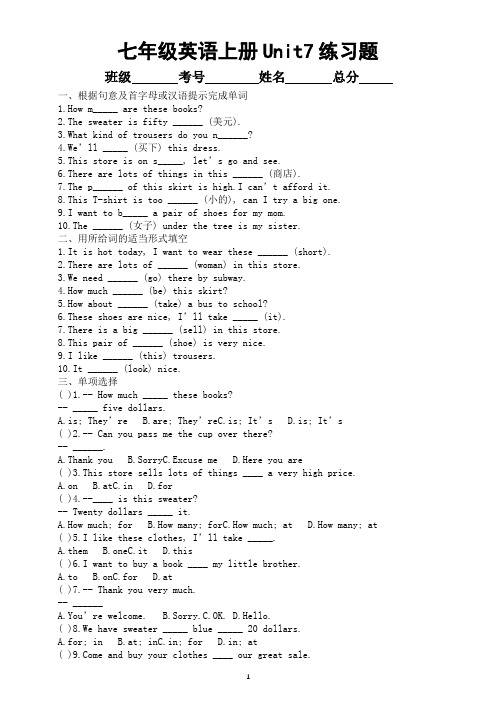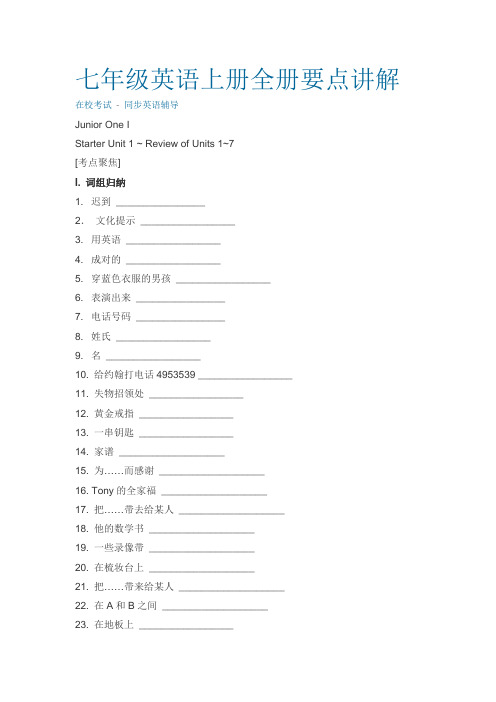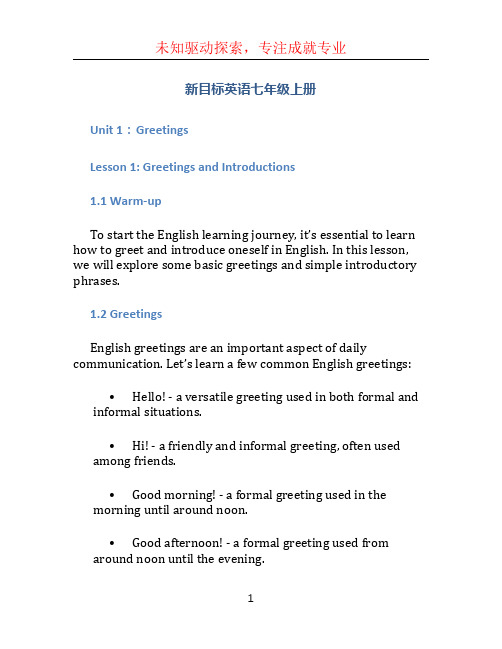新目标初中英语七年级上册
初中英语人教新目标七年级上册Unit7练习题(附参考答案)

七年级英语上册Unit7练习题班级考号姓名总分一、根据句意及首字母或汉语提示完成单词1.How m_____ are these books?2.The sweater is fifty ______ (美元).3.What kind of trousers do you n______?4.We’ll _____ (买下) this dress.5.This store is on s_____, let’s go and see.6.There are lots of things in this ______ (商店).7.The p______ of this skirt is high.I can’t afford it.8.This T-shirt is too ______ (小的), can I try a big one.9.I want to b_____ a pair of shoes for my mom.10.The ______ (女子) under the tree is my sister.二、用所给词的适当形式填空1.It is hot today, I want to wear these ______ (short).2.There are lots of ______ (woman) in this store.3.We need ______ (go) there by subway.4.How much ______ (be) this skirt?5.How about ______ (take) a bus to school?6.These shoes are nice, I’ll take _____ (it).7.There is a big ______ (sell) in this store.8.This pair of ______ (shoe) is very nice.9.I like ______ (this) trousers.10.It ______ (look) nice.三、单项选择( )1.-- How much _____ these books?-- _____ five dollars.A.is; They’reB.are; They’reC.is; It’sD.is; It’s( )2.-- Can you pass me the cup over there?-- ______.A.Thank youB.SorryC.Excuse meD.Here you are( )3.This store sells lots of things ____ a very high price.A.onB.atC.inD.for( )4.--____ is this sweater?-- Twenty dollars _____ it.A.How much; forB.How many; forC.How much; atD.How many; at ( )5.I like these clothes, I’ll take _____.A.themB.oneC.itD.this( )6.I want to buy a book ____ my little brother.A.toB.onC.forD.at( )7.-- Thank you very much.-- ______A.You’re welcome.B.Sorry.C.OK.D.Hello.( )8.We have sweater _____ blue _____ 20 dollars.A.for; inB.at; inC.in; forD.in; at( )e and buy your clothes ____ our great sale.A.on;B.inC.forD.at( )10.-- What do you want?-- I want _____A.two pair of sockB.two pair of socksC.two pairs of sockD.two pairs of socks四、翻译句子1.这件红色的短裙多少钱?_____ _____ is this red dress?2.我要买下它。
成都起航教育人教版新目标英语七年级上册全册要点讲解

七年级英语上册全册要点讲解在校考试- 同步英语辅导Junior One IStarter Unit 1 ~ Review of Units 1~7[考点聚焦]I. 词组归纳1. 迟到________________2.文化提示_________________3. 用英语_________________4. 成对的_________________5. 穿蓝色衣服的男孩_________________6. 表演出来________________7. 电话号码________________8. 姓氏_________________9. 名_________________10. 给约翰打电话4953539 _________________11. 失物招领处_________________12. 黄金戒指_________________13. 一串钥匙_________________14. 家谱___________________15. 为……而感谢___________________16. Tony的全家福___________________17. 把……带去给某人___________________18. 他的数学书___________________19. 一些录像带___________________20. 在梳妆台上___________________21. 把……带来给某人___________________22. 在A和B之间___________________23. 在地板上_________________24. 打电脑游戏__________________25. 棒球球棒__________________26. 一个网球拍__________________27. 想做某事__________________28. 欢迎来到我们学校___________________29. 加入学校体育中心___________________30. 马上加入我们吧!___________________31. 丰富的体育用品收藏___________________32. 在电视上看篮球比赛___________________33. 跑步明星__________________34. 吃健康的食物__________________35. 就早餐而言__________________36. 食物清单__________________37. 一年的这个时候__________________38. 以一个非常优惠的价格_________________39. 各种颜色的毛衣_________________40. 出售________________41. 看一下…… _________________42. 服装店_________________43. 篮球打得好_________________44. 非常喜欢…… _________________II. 句型归纳1. _______ _______ name?My name is Dale.2. _______ _______ _______ your aunt?She’s 37 ________ old.3. _______ that?It’s Gina.4. _______ this _______ English?It’s letter A.5. _______ play soccer today!Great, that sounds good.6. _______ _______ are these desks?They are brown.7. _______ _______ you _______ watch?W-A-T-C-H.8. _______ that her eraser?No, _______ isn’t.9. _______ telephone number?_______ 7385098.10. _______ this your brother?Yes, _______ is.11. _______ _______ his books?They’re on the dresser.12. _______ _______ on the dresser?Yes, they are.13. _______ they have a computer?No, they _______.14. _______ he have a soccer ball?Yes, he _______.15. I like oranges but I ______ like bananas.16. Their father likes broccoli but he ______ like hamburgers.17. _______ _______ your sister like for lunch?She likes fish and salad for lunch.18. _______ _______ are the red socks?_______ 3 dollars.III. 考点归纳1. Hello, Eli. Good morning. 嗨,埃丽。
七年级英语上册(人教新目标GoForIt!)Unit1第1课时(1a2d)教学设计

一、教学目标
(一)知识与技能
1.掌握并运用本节课的生词,如pen, pencil, ruler, eraser, schoolbag, book, coat等,学会正确使用这些词汇描述物品。
2.学会使用What's this/that?和Is this/that...?两个句型进行物品的询问和确认。
2.图片展示:教师展示一组与学习用品相关的图片,如铅笔、尺子、橡皮等,引导学生用英语说出这些物品的名称。
3.导入新课:教师提出问题:“How can we ask for the name of an object in English?”,引导学生思考并回答,顺势导入新课。
(二)讲授新知
1.生词学习:教师呈现生词卡片,带领学生学习新词汇,如pen, pencil, ruler, eraser, schoolbag, book, coat等,并让学生跟读、模仿。
3.写作练习:教师给出一个主题,如“我的书包”,让学生运用所学词汇和句型,写一篇简短的作文。
(五)总结归纳
1.学生总结:教师邀请学生分享本节课的学习收获,如新学的词汇、句型和语法知识。
2.教师点评:教师针对学生的表现,给予积极的评价和鼓励,指出需要改进的地方。
3.课后作业:教师布置与本节课相关的课后作业,如完成练习册上的相关题目,巩固所学知识。
4.分层教学:关注学生的个体差异,针对不同学生的学习需求,设计难易程度不同的教学活动,使每个学生都能在课堂上得到锻炼和提升。
5.激发兴趣:通过游戏、竞赛等形式,激发学生的学习兴趣,调动学生的积极性,让学生在轻松愉快的氛围中学习英语。
6.课后巩固:布置富有挑战性的课后作业,如制作英语小报、录制英语视频等,让学生在课后对所学知识进行巩固和拓展。
新目标英语七年级上册 (2)

新目标英语七年级上册Unit 1:GreetingsLesson 1: Greetings and Introductions1.1 Warm-upTo start the English learning journey, it’s essential to learn how to greet and introduce oneself in English. In this lesson, we will explore some basic greetings and simple introductory phrases.1.2 GreetingsEnglish greetings are an important aspect of daily communication. Let’s learn a few common English greetings:•Hello! - a versatile greeting used in both formal and informal situations.•Hi! - a friendly and informal greeting, often used among friends.•Good morning! - a formal greeting used in the morning until around noon.•Good afternoon! - a formal greeting used from around noon until the evening.•Good evening! - a formal greeting used in the evening and at night.1.3 IntroductionsNext, let’s learn how to introduce ourselves in English. Here’s an example of a basic self-introduction:•A: Hello! My name is Alice. What’s your name?•B: Hi Alice! Nice to meet you. I’m Bob.In English, when introducing oneself, it is essential to include your name and greet the other person. It’s also customary to respond by offering a pleasant response when someone introduces themselves to you.1.4 PracticeTo reinforce the learning, let’s practice greetings and introductions. Role-play different scenarios with your classmates or use the following questions as prompts:•What’s your name?•How old are you?•Where are you from?Remember to use appropriate greetings and polite language during these interactions.1.5 Speaking ChallengeFor the speaking challenge, choose a partner and practice exchanging introductions. Make sure to greet each other and ask questions using the phrases you have learned.Lesson 2: Classroom English2.1 Warm-upIn this lesson, we will learn essential classroom English phrases that will help you communicate effectively with your teachers and peers.2.2 Classroom InstructionsTo ensure smooth classroom activities, teachers often use specific instructions in English. Let’s familiarize ourselves with some common classroom instructions:•Please sit down.•Raise your hand.•Stand up.•Open your book.•Close your book.•Pay attention.•Take out your pen/pencil.•Put away your belongings.2.3 Expressing NeedsWhen you need something in the classroom, it’s important to know how to express your needs. Here are some useful phrases:•Can I borrow a pen, please?•May I go to the restroom?•I need a piece of paper.•Can you help me, please?•I don’t understand.2.4 PracticeTo practice classroom English, engage in role-playing activities with your classmates. Act out different classroom scenarios and use the classroom instructions and phrases you have learned.2.5 Speaking ChallengeFor the speaking challenge, pair up with a classmate and take turns giving instructions or expressing needs. Practice using the phrases from this lesson and respond accordingly.Unit 2: My School LifeLesson 3: Daily Routines3.1 Warm-upIn this lesson, you will learn how to talk about your daily routines in English. Daily routines refer to the regular activities you engage in every day, such as waking up, eating breakfast, going to school, etc.3.2 Talking about Daily RoutinesTo talk about daily routines, we use time expressions and action verbs. Here are some examples:•I wake up at 7 am.•I brush my teeth.•I have breakfast at 7:30 am.•I go to school at 8 am.3.3 Adverbs of FrequencyWhen discussing daily routines, we often mention how frequently we perform certain actions. Adverbs of frequency help us express this. Here are some common adverbs of frequency:•Always•Usually•Often•Sometimes•Rarely•Never3.4 PracticeTo practice talking about daily routines, create a schedule for an average school day. Include the time and actions you typically perform. Share your schedule with a partner and discuss similarities and differences.3.5 Speaking ChallengeFor the speaking challenge, create a dialogue with a classmate where you discuss your daily routines. Incorporate the adverbs of frequency and time expressions into your conversation.Unit 3: My FamilyLesson 4: My Family4.1 Warm-upIn this lesson, we will learn vocabulary related to family members and how to describe them in English.4.2 Family VocabularyLet’s start by learning some common family member vocabulary:•Mother•Father•Sister•Brother•Grandmother•Grandfather•Aunt•Uncle•Cousin4.3 Describing Family MembersOnce you have learned the family member vocabulary, practice describing your family members using simple sentences. For example:•My mother is kind and caring.•My sister is funny and creative.•My grandfather likes to tell stories.4.4 PracticeTo reinforce your understanding and vocabulary, create a family tree. Include the names of your family members and describe their characteristics using adjectives.4.5 Speaking ChallengeFor the speaking challenge, create a presentation about your family. Introduce each family member and describe their personality traits. Use the vocabulary and sentence structures you have learned in this lesson.ConclusionIn this document, we have covered the first three units of the New Target English Grade 7 textbook. These units focused on greetings, classroom English, daily routines, and family vocabulary. By practicing these essential topics, you will be equipped with basic English communication skills that will serve as a foundation for further learning. Keep practicing and exploring the English language!。
七年级英语上新目标Unit1--12单元重点及语法总复习

初中七年级上语法总复习一.Be 动词(am, is, are)的用法口诀:I 用am , you 用are ,is 连着他(he)她(she)它(it)。
单数统统用is,复数一律都用are. 变疑问,往前提,句末问好莫丢弃,变否定,更容易,be 后not莫忘记,疑问否定任你变,句首大写莫迟疑。
注意:be 动词通常会和其他词连写在一起,如:I’m , what’s ,name’s, they’re等。
I ________ a student.You ________ Janpanese.He _______ my brother.She_______ very nice.My name ________Harry.I _______ 10 years old.Lilei _________ very tall. Mary, this _________ Tom.Miss Zhou ________ my teacher. What_____ this? The cat________ black.This book________ very interesting. Lilei and I __________ good friends. These ________ apples.Those_________ bananas.They _________students.________ she from China?________ you good at English? The books ________ on the desk.I ______ a boy. ______ you a boy? No, I _____ not.The girl______ Jack's sister.The dog _______ tall and fat.The man with big eyes _______ a teacher. ______ your brother in the classroom? Where _____ your mother?She ______ at home.How _______ your father.Mike and Liu Tao ______ at school. Whose dress ______ this?Whose socks ______ they?That ______ my red skirt.Who ______ I?The jeans ______ on the desk.Here ______many oranges for you. Here ______ some sweaters for you.The black pants ______ for Su Yang. This pair of boots ______ for Yang Ling. There some milk for me.Some tea ______ in the glass.Gao shan's shirt _______ over there.My sister's name ______Nancy.This ______ not Wang Fang's pencil.______ David and Helen from England? There ______ a girl in the room.There ______ some apples on the tree._______ there any kites in the classroom? _______ there any apple juice in the bottle? There _______ some bread on the plate.There _______ a boy, two girls, three men and ten women in the park.You, he and I ______ from China. My telephone number________8563-0770.1.通常情况下,人称代词的主格在句子中作主语。
初中英语人教新目标七年级上册Unit9练习题(附参考答案)

七年级英语上册Unit9练习题班级考号姓名总分一、根据句意及首字母或汉语提示完成单词1.My f_______ colour is green.2.I have one ______ (课) on the afternoon of Friday.3.I like English b______ it is interesting.4.This movie is so _____ (妙极了), I like it very much.5.S______ comes after Friday.6.I will ______ (完成) our homework in an hour.7.W_____ are you late for school?8.I am _____ (空闲的) today.9.I go to school f_____ Monday to Friday.10.This book is _______ (有用的).二、用所给词的适当形式填空1.Chinese and English are my favorite ________ (subject).2.Lily often _____ (have) music lessons on Wednesday.3.There are twenty - four ______ (hour) in a day.4.We will finish ______ (work) next week.puter is a _____ (use) invention.6.This lesson is ______ (bore), I don’t like it.7.Can he _____ (play) the guitar?8.I want ______ (know) about your family?9.My mother is busy _______ (cook).10.Please ______ (ask) that man.三、单项选择( )1.We have two lessons ____ Friday afternoon.A.atB.inC.onD.for( )2.The man often finishes _____ TV at 12:00 pm.A.watchingB.watchesC.watchD.to watch( )3.Today we have _____ lessons in the morning, the _____ is English.A.four; threeB.fourth; threeC.four; thirdD.fourth; third( )4.Science is difficult _____ fun.A.butB.andC.orD.so( )5._____ is the fifth day in a week.A.WednesdayB.ThursdayC.FridayD.Saturday( )6.--_____ do you like math?-- Because it is interesting.A.WhenB.WhyC.WhereD.What( )7.______favorite subject is English.What about you?A.IB.MyC.MeD.Mine( )8.My teacher _____ that we are free tomorrow.A.sayB.saysC.sayingD.to say( )9.I think English is _____ useful subject.A.anB.aC./D.the( )10.--______-- It’s OK.I have fun playing basketball.D.He is a lovely dog.E.Mr.Smith is.F.I don’t like our math teacher.G.What’s my favorite subject?八、句型转换1.I like English because it is interesting.(就划线部分提问)_____ _____ _____ like English?2.We have two Chinese lessons on Monday.(就划线部分提问)_____ _____ ____ ____ two Chinese lessons?3.My favorite subject is math.(就划线部分提问)_____ _____ _____ subject?4.always, with, he, us, games, plays (连词成句)_________________________5.on; I; busy; am; Friday; very (连词成句)_________________________附:参考答案一、1.favorite 2.lesson 3.because 4.cool 5.Saturday6.finish7.Why8.free9.from eful二、1.subjects 2.has 3.hours 4.working eful6.boring7.play8.to know9.cooking 10.ask三、1 -- 5 CACAB 6 -- 10 BBBBA四、1.from; to2.have two English lessons3.plays with4.Is that OK with you?5.That's for sure.五、1 -- 5 ECBDA六、1.fly 2.take 3.goes 4.buys 5.have6. visit7.see8.like9.are七、1 -- 5 BFEGD八、1.Why do you2.When do you have3.What's your favorite4.He always plays games with us.5.I am very busy on Friday.。
新目标英语七年级上Starter Unit 1 -Starter Unit 3期末复习知识梳理(含答案)

新目标英语七年级上Starter Unit 1 -Starter Unit 3期末知识梳理重点词汇good 好的,morning早晨,CD光盘,afternoon下午,evening晚上,how如何,are是,you你,I我,am 是,fine好的,thanks谢谢,OK好的,行,重点句型1.Good morning! 早上好!2.How are you ? 你好?3.I’m fine, thanks. 我很好,谢谢。
交际用语1.Good morning! 早上好!2.How are you ? 你好?3.I’m fine, thanks. 我很好,谢谢。
4.Hello! / Hi!重要语法1.学会如何与别人打招乎,互相问候。
2.字母读音分类【课文讲解】1.Good morning 早晨好!【用法透视】一般用于熟人、朋友或家人之间,比Hello和Hi要正式一些。
Good morning. 后可以带称呼语(如某人、某先生、某女士等)。
对方应答是Good morning或Morning。
其中morning指早上或上午(中午12点之前)。
如果了12点钟则用Good afternoon。
大约在下午5点种之后,晚上9点种之前使用Good evening。
约在9点种之后要说Good night。
例如:A:Good morning,class!同学们,你们好!B:Good morning,teacher!老师,早上好!Morning, Mum! 早上好,妈妈!Morning, Kate! 早上好,凯特!Good morning, Jim! 早上好,吉姆!Good morning, Han Mei! 早上好,韩梅!【拓展】问候语:东方人与西方人、中国人和外国人都有着不同的文化传统和风俗习惯,因此学习英语要注意英语语言的表达习惯,在不同的时间不同的场合使用不同的问候语。
(1) 初次见面相互问候How do you do?(2) Hello! 在口语中应用较广泛,多用于熟人、朋友、同学之间的相互问好,相当于汉语的“你好”。
人教新目标英语七年级上册Unit1单元教学设计

为了巩固本节课所学内容,提高学生的英语应用能力,特布置以下作业:
1.书面作业:
a.完成课本练习册中与本节课相关的练习题,包括填空、选择、改错等,以巩固词汇和语法知识。
b.根据课堂所学,编写一段关于自己的自我介绍,涵盖姓名、年龄、学校、班级等信息,要求使用一般现在时态。
c.收集并学习三个以上关于自我介绍的英语句型,拓展学生的词汇量和表达能力。
3.导入新课:教师通过视频和学生的回答,自然导入本节课的主题——自我介绍,并板书课题。
(二)讲授新知
1.教学内容:本节课主要学习如何用英语进行自我介绍,包括姓名、年龄、学校、班级等基本信息的表达。
2.教学方法:教师采用讲解、示范、互动等方式,引导学生学习本节课的重点词汇和句型。
3.教学过程:
a.教师呈现本节课的生词和短语,如:name、age、school、class、teacher、friend等,并进行讲解和示范。
2.任务型教学,培养能力:设计多样化的任务型活动,如小组讨论、角色扮演、课堂游戏等,引导学生积极参与,培养他们的听说读写能力。
3.分层次教学,关注个体差异:针对学生的不同水平,设计不同难度的教学任务,使每个学生都能在课堂上得到锻炼和提升。
4.情感教育,营造氛围:关注学生的情感需求,营造一个轻松、和谐、尊重的学习氛围,让学生在愉悦的情感状态下学习英语。
4.家长参与:
a.家长协助学生完成口语作业,给予鼓励和支持,提高学生的自信心。
b.家长监督学生完成书面作业,关注学生的学习进度,与教师保持沟通。
5.作业反馈:
a.学生在完成作业后,认真检查,确保作业质量。
b.教师在下次课堂上,针对作业情况进行点评,给予表扬和指导。
5.课后巩固,提高自主学习能力:布置适量的课后作业,鼓励学生利用网络、课外书籍等资源进行自主学习,提高学生的英语素养。
